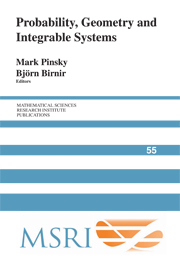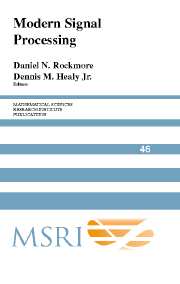Refine search
Actions for selected content:
52374 results in Statistics and Probability
Bayesian optimization of underground railway tunnels using a surrogate model
- Part of
-
- Journal:
- Data-Centric Engineering / Volume 6 / 2025
- Published online by Cambridge University Press:
- 30 June 2025, e32
-
- Article
-
- You have access
- Open access
- HTML
- Export citation
Needs-based collaborative filtering for embedded insurance recommendation on e-commerce platforms
-
- Journal:
- British Actuarial Journal / Volume 30 / 2025
- Published online by Cambridge University Press:
- 30 June 2025, e22
-
- Article
-
- You have access
- Open access
- HTML
- Export citation
Molecular epidemiological surveillance of monkeypox virus in Indonesia from 2023 to 2024
-
- Journal:
- Epidemiology & Infection / Volume 153 / 2025
- Published online by Cambridge University Press:
- 30 June 2025, e79
-
- Article
-
- You have access
- Open access
- HTML
- Export citation
Potentials of administrative informatics for the analysis of policymaking: notes on the integration of administrative informatics into the policy cycle
- Part of
-
- Journal:
- Data & Policy / Volume 7 / 2025
- Published online by Cambridge University Press:
- 30 June 2025, e47
-
- Article
-
- You have access
- Open access
- HTML
- Export citation
A large deviation principle for block models
- Part of
-
- Journal:
- Combinatorics, Probability and Computing / Volume 34 / Issue 5 / September 2025
- Published online by Cambridge University Press:
- 30 June 2025, pp. 680-753
-
- Article
- Export citation
Spatiotemporal dynamics of dengue spread in Rio de Janeiro during epidemic periods
-
- Journal:
- Epidemiology & Infection / Volume 153 / 2025
- Published online by Cambridge University Press:
- 30 June 2025, e78
-
- Article
-
- You have access
- Open access
- HTML
- Export citation
Common pairs of graphs
- Part of
-
- Journal:
- Combinatorics, Probability and Computing / Volume 34 / Issue 5 / September 2025
- Published online by Cambridge University Press:
- 30 June 2025, pp. 649-670
-
- Article
- Export citation
Informal savings groups and food security during the COVID-19 pandemic: evidence from Nigeria
-
- Journal:
- Data & Policy / Volume 7 / 2025
- Published online by Cambridge University Press:
- 30 June 2025, e46
-
- Article
-
- You have access
- Open access
- HTML
- Export citation

Probability, Geometry and Integrable Systems
-
- Published online:
- 27 June 2025
- Print publication:
- 17 March 2008
Office-in-the-Loop: an investigation into Agentic AI for advanced building HVAC control systems
- Part of
-
- Journal:
- Data-Centric Engineering / Volume 6 / 2025
- Published online by Cambridge University Press:
- 27 June 2025, e31
-
- Article
-
- You have access
- Open access
- HTML
- Export citation
Data for peace: how novel data sources and technology can enhance peace?
- Part of
-
- Journal:
- Data & Policy / Volume 7 / 2025
- Published online by Cambridge University Press:
- 27 June 2025, e45
-
- Article
-
- You have access
- Open access
- HTML
- Export citation
Transitioning from microscopy to PCR for protozoa in Norway – Impact on detection of protozoa and helminths: A register study
-
- Journal:
- Epidemiology & Infection / Volume 153 / 2025
- Published online by Cambridge University Press:
- 26 June 2025, e80
-
- Article
-
- You have access
- Open access
- HTML
- Export citation
On the size of temporal cliques in subcritical random temporal graphs
- Part of
-
- Journal:
- Combinatorics, Probability and Computing / Volume 34 / Issue 5 / September 2025
- Published online by Cambridge University Press:
- 26 June 2025, pp. 671-679
-
- Article
- Export citation

Modern Signal Processing
-
- Published online:
- 25 June 2025
- Print publication:
- 05 April 2004
Probabilistic digital twins for geotechnical design and construction
- Part of
-
- Journal:
- Data-Centric Engineering / Volume 6 / 2025
- Published online by Cambridge University Press:
- 25 June 2025, e30
-
- Article
-
- You have access
- Open access
- HTML
- Export citation
Development, verification, and certification of a digital twin for a voyage data recorder
- Part of
-
- Journal:
- Data-Centric Engineering / Volume 6 / 2025
- Published online by Cambridge University Press:
- 25 June 2025, e14
-
- Article
-
- You have access
- Open access
- HTML
- Export citation
The future of learning or the future of dividing? Exploring the impact of generative artificial intelligence on higher education
-
- Journal:
- Data & Policy / Volume 7 / 2025
- Published online by Cambridge University Press:
- 25 June 2025, e44
-
- Article
-
- You have access
- Open access
- HTML
- Export citation
Prevalence of Mollicutes in pregnant women undergoing high-risk prenatal care at a maternal and child reference unit in Bahia, Brazil
-
- Journal:
- Epidemiology & Infection / Volume 153 / 2025
- Published online by Cambridge University Press:
- 25 June 2025, e73
-
- Article
-
- You have access
- Open access
- HTML
- Export citation
A review of the environmental, social, and governance reporting among global pension plans and a proposed reporting framework
-
- Journal:
- British Actuarial Journal / Volume 30 / 2025
- Published online by Cambridge University Press:
- 25 June 2025, e20
-
- Article
-
- You have access
- Open access
- HTML
- Export citation
A large outbreak of invasive Group B Streptococcus Sequence Type 283 infection linked to physical contact of freshwater fish
-
- Journal:
- Epidemiology & Infection / Volume 153 / 2025
- Published online by Cambridge University Press:
- 24 June 2025, e76
-
- Article
-
- You have access
- Open access
- HTML
- Export citation



















